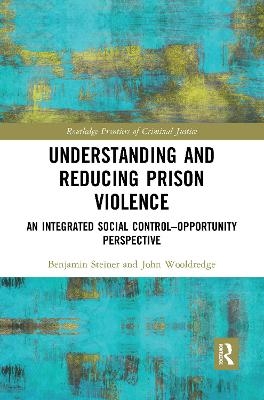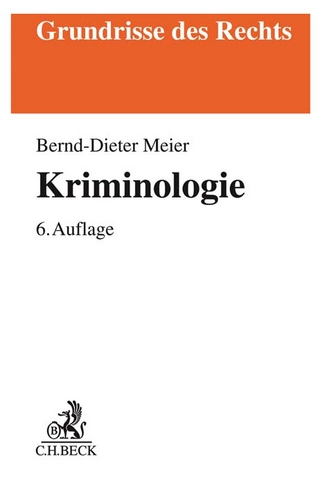
Understanding and Reducing Prison Violence
Routledge (Verlag)
978-1-032-08281-3 (ISBN)
Prison violence is not a random process; rates of violence vary across prisons and the odds of perpetrating violence or experiencing violent victimization vary across inmates and staff. A comprehensive understanding of the causes of prison violence therefore requires consideration of both individual and prison characteristics.
Building on large dataset comprising 5,500 inmates and 1,800 officers across 45 prisons located across two of the United States (Ohio and Kentucky), this book showcases one of the largest and most comprehensive studies of prisons carried out to date. It considers both the implications of the study for theories of prison violence and the implications of the study for preventing violence in prisons. It will be of interest to academics, practitioners, and policy makers alike.
Benjamin Steiner was a professor in the School of Criminology and Criminal Justice at the University of Nebraska, Omaha until his death in January 2019. He held a PhD in Criminal Justice from the University of Cincinnati. His research and publications focused on prisoner misconduct and victimization, the consequences of in-prison misconduct and the use of solitary confinement for sanctioning offenders, and correctional officers’ attitudes and behaviors. He amassed over 60 publications during his short career, including peer-reviewed journal articles, books, and book chapters. John Wooldredge holds a PhD in Sociology from the University of Illinois. He is a professor in the School of Criminal Justice at the University of Cincinnati. His research and publications focus on institutional corrections (crowding, inmate crimes, and victimizations) and criminal case processing (sentencing and recidivism, and micro- versus macro-level extralegal disparities in case processing and outcomes). He is currently involved in an NIJ-funded study of the use and impacts of restrictive housing in Ohio prisons (with Josh Cochran), and in projects focusing on prison program effects on subsequent misconduct during incarceration and post-release recidivism, and extralegal disparities in prison sanctions imposed for rule violations.
Chapter 1. Introduction: Explaining Prison Violence, A Multi-level Social Control–Opportunity Perspective, Project Background, Overview of Chapters, Chapter 2. Prison Violence: Explanations and Evidence: Violent Offending and Victimization Among Inmates, Deprivation theory, Importation theory, Management theories, Integrated models, General theories of crime and victimization, Violent Victimization of Prison Officers, Chapter 3. A Multilevel Social Control–Opportunity Framework for Understanding Prison Violence: Inmate Violence, Inmate-level contributors to violent offending, Prison-level contributors to violent offending, Managerial contributors to violent offending, Inmate Victimization, Inmate-level contributors to violent victimization, Prison-level contributors to violent victimization, Officer Victimization, Officer-level contributors to violent victimization, Prison-level contributors to officer victimization, Chapter 4. Study Attributes: Samples, Facility samples, Cross-sectional inmate samples, Longitudinal inmate samples, Correctional officer samples, Data Sources, Inmate surveys, Officer surveys, Warden survey and observation instrument, Measures, Full sample of Ohio and Kentucky inmates, Sub-sample of Ohio inmates confronted by prison staff for rule violations, Sample of Ohio and Kentucky correctional officers, Sample of Ohio and Kentucky prisons, Statistical Analysis, References Chapter 5. Identifying the Most Relevant Effects on Violent Offending and Victimization in Ohio and Kentucky Prisons: Inmate Offending Full sample, Ohio sample, Reduced sample, Inmate Victimization: Full Sample, Violence at Work: Correctional Officer Sample, Chapter 6. Implications for a Multilevel Social Control–Opportunity Theory of In-Prison Violence: A Theoretical Understanding of Violent Offending and Victimization in Prison, Inmate violence, Inmate victimization by violence, Officer victimization and safety, A Theoretically Informed Approach to Reducing In-Prison Violence, Chapter 7. Informing Strategies for Preventing Prison Violence: Facilities and Structure, Custodial Workforce and Resources, Adequately educated, well-trained, and experienced officers, Properly equipped staff, Regular communication among officers, Strong leadership with clear communication of officers’ roles, Proper supervision and support of officers, Effective use of officers, Healthy officer culture, Encourage officers to develop constructive relationships with inmates, Diverse officer workforce, Professional work environment, Regular searches of inmates and cells, Staff exposure in housing units and living areas, Maintain staff perceptions of a safe environment, Programs and Services, Programs to address inmate needs, Productive time use, Facilitate inmate visitation, Sufficient operational budgets, Outlets for inmates to relieve stress, Inmate Populations, Managing large populations, Avoid feeding racial tensions, Managing inmates with authority issues, Considering an inmate’s age and sex, Addressing the recency of substance use, Managing gang members, Preserving (healthy) family relationships, Managing inmates with less commitment to conventional goals, Chapter 8. In-prison Violence: Non-utilitarian Considerations and Future Research: Inmate Litigation Highlighting the Injustice of Violence in Prison, Study Limitations and Directions for Future Research, Geographic scope, Operational concepts, Structural equation modeling within a multilevel framework
| Erscheinungsdatum | 03.08.2021 |
|---|---|
| Reihe/Serie | Routledge Frontiers of Criminal Justice |
| Verlagsort | London |
| Sprache | englisch |
| Maße | 156 x 234 mm |
| Gewicht | 276 g |
| Themenwelt | Sachbuch/Ratgeber ► Gesundheit / Leben / Psychologie |
| Recht / Steuern ► EU / Internationales Recht | |
| Recht / Steuern ► Strafrecht ► Kriminologie | |
| Sozialwissenschaften ► Pädagogik ► Sozialpädagogik | |
| Sozialwissenschaften ► Soziologie | |
| ISBN-10 | 1-032-08281-X / 103208281X |
| ISBN-13 | 978-1-032-08281-3 / 9781032082813 |
| Zustand | Neuware |
| Haben Sie eine Frage zum Produkt? |
aus dem Bereich


